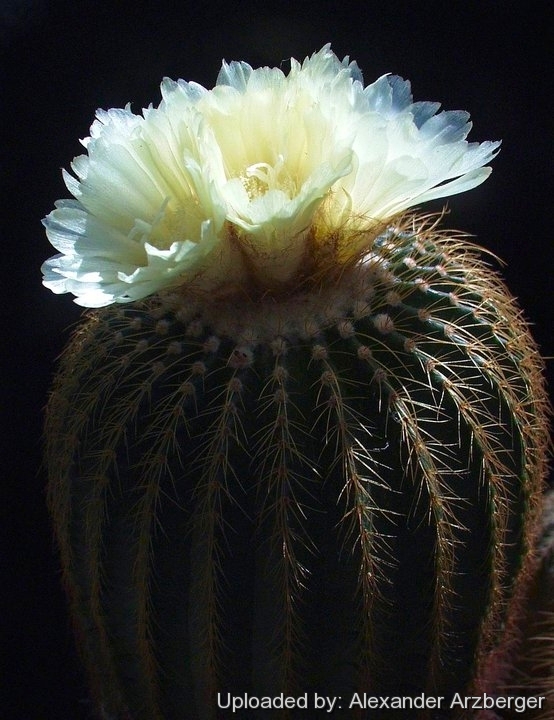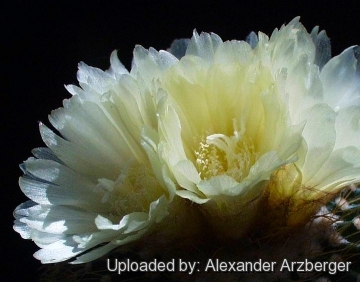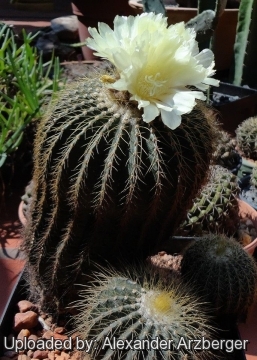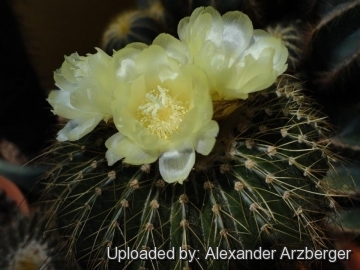Accepted Scientific Name: Parodia schumanniana (Nicolai) F.H.Brandt
Kakteen Orch. Rundschau 1982(4): 62 (1982)

Parodia grossei var. aureispina Photo by: Alexander Arzberger
Origin and Habitat: Paraguay, Cerro Acati, Colonia Indipendencia, Depart. Guairá and also Cerro Pelado near Villarica.
Synonyms:
See all synonyms of Parodia schumanniana
back
Accepted name in llifle Database:Parodia schumanniana (Nicolai) F.H.BrandtKakteen Orch. Rundschau 1982(4): 62 (1982)Synonymy: 24
Accepted name in llifle Database:Parodia schumanniana subs. claviceps (F.Ritter) Hofacker & P.J.BraunCactaceae Consensus Init. 6: 12. 1998Synonymy: 5
back
Description: As the name implies Parodia grossei var. aureispinaSN|1154]]SN|33219]] is a distinct yellow spined form of Parodia grosseiSN|1154]]SN|1154]] (syn: Parodia schumannianaSN|1154]]SN|1141]]). It distinguishes from Parodia grosseiSN|1141]]SN|1154]] by its smaller and shorter stems (less than 20 cm thick and 1 metre long), while the number of ribs (about 16) is the same. The spines are much weaker, golden yellow to reddish yellow (brown), but more numerous 8-11, all similar, the lowermost longer. Occasionally 1 to 3 central spines are present a the bottom and (rarely) an additional central spine is formed among the upper 4 radial spines. The seedlings are similar to standard Parodia grosseiSN|1154]]SN|1154]] but the spines are more numerous (often two time more numerous), radial and central are all very similar, but the lowermost radial are noticeably longer.
Flowers and seeds: Like Parodia grosseiSN|33219]]SN|1154]].
Seeds. Red brown, campanulate, 0.7 mm long, circumference at the hilum 0.7 mm and 0.5 mm thick, testa with very fine elongated warts arranged in rows. The hilum is dirty white, large a the whole basal size of the test, and has an elevated ring around. The centre of the hilum is raised (not flat) and the micropyle is not or hardly visible.
Subspecies, varieties, forms and cultivars of plants belonging to the Parodia schumanniana
 Parodia ampliocostata (F.Ritter) F.H.Brandt: has more ribs, more spines, multiple central spines, of which the lowest one conspicuously longer and pale yellow anthers. Distribution: Cordillera de los Altos, Paraguarí, Paraguay.
Parodia ampliocostata (F.Ritter) F.H.Brandt: has more ribs, more spines, multiple central spines, of which the lowest one conspicuously longer and pale yellow anthers. Distribution: Cordillera de los Altos, Paraguarí, Paraguay. Parodia grossei (K.Schum.) F.H.Brandt: has stems to 1.7 m high and 30 cm thick, 3-7 long bristly white (or brownish) spines the longer one 4 cm long. Distribution: between Carepegua and southeast of the Cerro Acahay, Paraguarí, Paraguay.
Parodia grossei (K.Schum.) F.H.Brandt: has stems to 1.7 m high and 30 cm thick, 3-7 long bristly white (or brownish) spines the longer one 4 cm long. Distribution: between Carepegua and southeast of the Cerro Acahay, Paraguarí, Paraguay. Parodia grossei var. aureispina (F.Ritter) F.H.Brandt: has stems to 1 m high and 20 cm thick, 8-11 long bristly golden yellow to reddish yellow spines the lowest the longer. Distribution: Cerro Acati, Colonia Indipendencia, Depart. Guairá and Cerro Pelado near Villarica.
Parodia grossei var. aureispina (F.Ritter) F.H.Brandt: has stems to 1 m high and 20 cm thick, 8-11 long bristly golden yellow to reddish yellow spines the lowest the longer. Distribution: Cerro Acati, Colonia Indipendencia, Depart. Guairá and Cerro Pelado near Villarica. Parodia schumanniana (Nicolai) F.H.Brandt: up to 1,8 m tall, areoles 7-15 mm apart, and 0-1 central spine. Distribution: Paraguay and north-eastern Argentina.
Parodia schumanniana (Nicolai) F.H.Brandt: up to 1,8 m tall, areoles 7-15 mm apart, and 0-1 central spine. Distribution: Paraguay and north-eastern Argentina.- Parodia schumanniana subs. claviceps (F.Ritter) Hofacker & P.J.Braun: less than 50 cm tall, areoles only 3-4 mm apart, and 1-3 central spines. Distribution: Rio Grande do Sul, Brazil.
Bibliography: Major references and further lectures
1) Friedrich Ritter "Kakteen in Südamerika: Ergebnisse meiner 20 jährigen Feldforschungen" volume 1 Selbstverlag, 1979
 Parodia grossei var. aureispina Photo by: Alexander Arzberger
Parodia grossei var. aureispina Photo by: Alexander Arzberger Parodia grossei var. aureispina Photo by: Alexander Arzberger
Parodia grossei var. aureispina Photo by: Alexander Arzberger Parodia grossei var. aureispina Photo by: Alexander Arzberger
Parodia grossei var. aureispina Photo by: Alexander Arzberger Parodia grossei var. aureispina Photo by: Alexander Arzberger
Parodia grossei var. aureispina Photo by: Alexander ArzbergerCultivation and Propagation: Frost Tolerant as low as -4°C (or possibly colder) but in cultivation it is best to avoid any frost when during the winter the temperature can go down to 2° C without any harm so long as the compost is very dry. During the summer it is best to keep the plants outside where the temperature can rise to over 30 C with no harm to the plant.
Allows good drainage and use a an open and free draining mineral compost that allows therefore roots to breath.
They like only a short winter's rest and should be kept almost completely dry during the winter months, If the soil is allowed to be dry for too long root loss could follow but equally the same result would occur if the plants are both wet and cold. From March onwards the plant will begin to grow and watering should be increased gradually until late May when the plant should be in full growth.
Water regularly during the summer so long as the plant pot is allowed to drain and not sit in a tray of water. During hot weather you may need to water the plants more frequently so long as the plant is actively growing. From late September watering should be reduced to force the plant to go in to a state of semi dormancy, by October you should be back in to the winter watering regime.
Need full sun avoiding only the harshest summer sun, if kept too dark they may become overly lush and could be prone to rotting due to over watering, they will also be shy to produce flowers.
Feeding may not be necessary at all if the compost is fresh then, feed in summer only if the plant hasn't been repotted recently. Do not feed the plants from September onwards as this can cause lush growth which can be fatal during the darker cold months.
Repotting should be done every other year or every three years, annual potting is not necessary. Do not be tempted to over pot as this will cause the unused compost to go stagnant and you may loose the plant.
Propagation: Seed sowing and cuttings.
Your Photos

by Alexander Arzberger
















